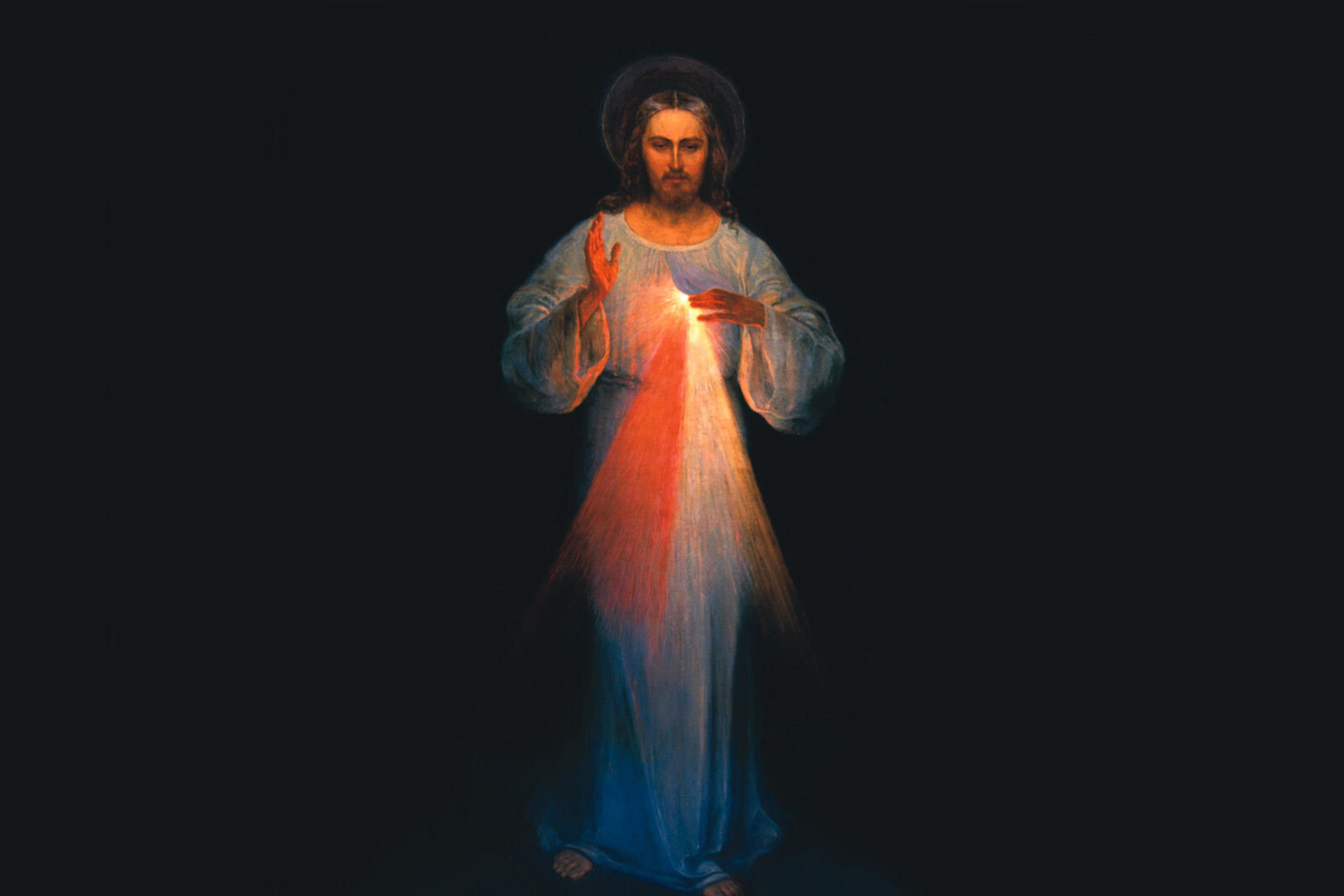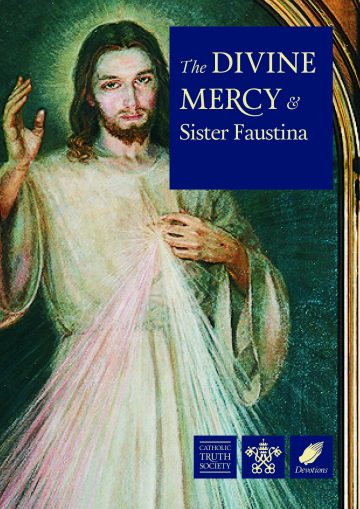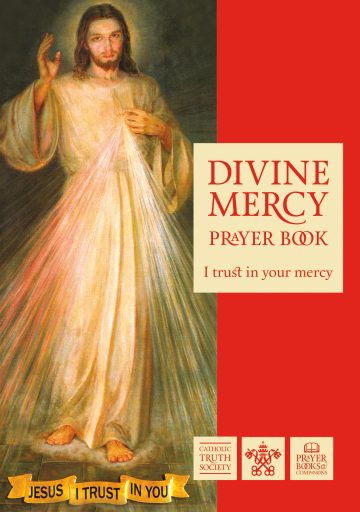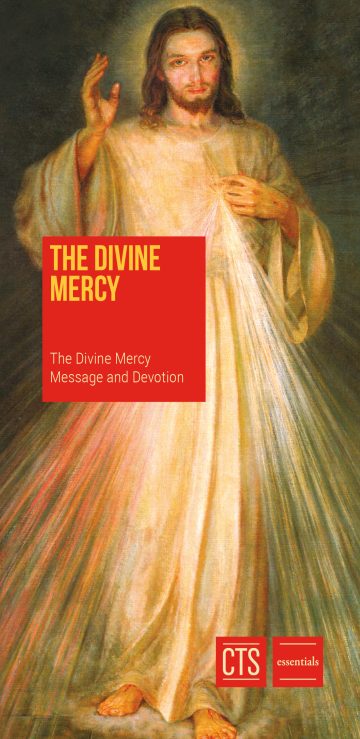The Feast of the Divine Mercy (Divine Mercy Sunday)
Among all of the elements of devotion to the Divine Mercy requested by our Lord through St Faustina Kowalska, the Feast of Mercy holds first place. The Lord’s will with regard to its establishment was already made known in His first revelation to the saint, as recorded in her Diary. In all, there were 14 revelations concerning the desired feast. The most comprehensive revelation can be found in Diary entry 699:
My daughter, tell the whole world about My inconceivable mercy. I desire that the Feast of Mercy be a refuge and shelter for all souls, and especially for poor sinners. On that day the very depths of My tender mercy are open. I pour out a whole ocean of graces upon those souls who approach the fount of My mercy. The soul that will go to Confession and receive Holy Communion shall obtain complete forgiveness of sins and punishment. On that day all the divine floodgates through which grace flow are opened. Let no soul fear to draw near to Me, even though its sins be as scarlet. My mercy is so great that no mind, be it of man or of angel, will be able to fathom it throughout all eternity. Everything that exists has come forth from the very depths of My most tender mercy. Every soul in its relation to Me will contemplate My love and mercy throughout eternity. The Feast of Mercy emerged from My very depths of tenderness. It is My desire that it be solemnly celebrated on the first Sunday after Easter. Mankind will not have peace until it turns to the Fount of My Mercy.
Our Lord’s explicit desire is that this feast be celebrated on the first Sunday after Easter. This Sunday is designated in the liturgy as the Octave Day of Easter. It was officially called the Second Sunday of Easter after the liturgical reform of Vatican II. Now, by the Decree of the Congregation for Divine Worship and the Discipline of the Sacraments, the name of this liturgical day has been changed to: Second Sunday of Easter, or Divine Mercy Sunday. Saint John Paul II made the surprise
announcement of this change in his homily at the canonisation of St Faustina on 30th April, 2000. There, he declared: “It is important then that we accept the whole
message that comes to us from the word of God on this Second Sunday of Easter, which from now on throughout the Church, will be called ‘Divine Mercy Sunday.’”
Liturgically the Easter Octave has always been centered on the theme of Divine Mercy and forgiveness. Divine Mercy Sunday, therefore, point us to the merciful love of God that lies behind the whole Paschal Mystery – the whole mystery of the death, burial and resurrection of Christ – made present for us in the Eucharist. In this way, it also sums up the whole Easter Octave. As Saint John Paul II pointed out in his Regina Caeli address on Divine Mercy Sunday, 1995: “the whole Octave of Easter is like a single day,” and the Octave Sunday is meant to be the day of “thanksgiving for the goodness God has shown to man in the whole Easter mystery.”
How to prepare to and celebrate Divine Mercy Sunday
Jesus asked Sr Faustina to pray the special novena as a preparation to the Feast of the Divine Mercy:
I desire that during these nine days you bring souls to the fountain of My mercy, that they may draw there from strength and refreshment and whatever grace they have need of in the hardships of life, and especially at the hour of death. (1209)
The novena to the Divine Mercy is typically nine days of prayer with a specific Intention for each day and followed by the Chaplet. The Chaplet can be said anytime, but the Lord specifically asked that it be recited as a novena. He promised:
By this Novena (of Chaplets), I will grant every possible grace to souls. (796)
Thus, to fittingly observe the Feast of Mercy, we should:
1. Celebrate the Feast on the Sunday after Easter;
2. Sincerely repent of all our sins;
3. Place our complete trust in Jesus;
4. Go to confession, preferably before that Sunday;
5. Receive Holy Communion on the day of the Feast;
6. Venerate the Image of the Divine Mercy;
7. Be merciful to others, through our actions, words, and prayers on their behalf.
The Image of the Merciful Jesus
In 1931, our Lord appeared to St Faustina in a vision. She saw Jesus clothed in a white garment with His right hand raised in blessing. His left hand was touching His garment in the area of the Heart, from where two large rays came forth, one red and the other pale. She gazed intently at the Lord in silence, her soul filled with awe, but also with great joy. Jesus said to her:
Paint an image according to the pattern you see, with the signature: Jesus, I trust in You… I promise that the soul that will venerate this image will not perish. I also promise victory over [its] enemies already here on earth, especially at the hour of death. I Myself will defend it as My own glory. (47, 48) I am offering people a vessel with which they are to keep coming for graces to the fountain of mercy. That vessel is this image with the signature: Jesus, I trust in You (327). I desire that this image be venerated, first in your chapel, and [then] throughout the world. (47)
At the request of her spiritual director, St Faustina asked the Lord about the meaning of the rays in the image. She heard these words in reply:
The two rays denote Blood and Water. The pale ray stands for the Water which makes souls righteous. The red ray stands for the Blood which is the life of souls… These two rays issued forth from the depths of My tender mercy when My agonized Heart was opened by a lance on the Cross… Happy is the one who will dwell in their shelter, for the just hand of God shall not lay hold of him. (299) By means of this image I shall grant many graces to souls. It is to be a reminder of the demands of My mercy, because even the strongest faith is of no avail without works. (742)
These words indicate that the Image represents the graces of Divine Mercy poured out upon the world, especially through Baptism and the Eucharist.
Many different versions of this image have been painted, but our Lord made it clear that the painting itself is not what is important. When St Faustina first saw the original image that was being painted under her direction by Eugeniusz Kazimirowski in Vilnius in 1934, she wept in disappointment and complained to Jesus: Who will paint You as beautiful as You are? (313). In answer, she heard these words:
Not in the beauty of the colour, nor of the brush lies the greatness of this image, but in My grace. (313)
So no matter which version of the Image we prefer, we can be assured that it is a vehicle of God’s grace, if it is revered with trust in His mercy.
The Chaplet of Divine Mercy
In 1935, St Faustina received a vision of an angel sent by God to chastise a certain city. She began to pray for mercy, but her prayers were powerless. Suddenly she saw the Holy Trinity and felt the power of Jesus’ grace within her. At the same time she found herself pleading with God for mercy with words she heard interiorly:
Eternal Father, I offer You the Body and Blood, Soul and Divinity of Your dearly beloved Son, Our Lord Jesus Christ, in atonement for our sins and those of the whole world; for the sake of His sorrowful Passion, have mercy on us. (475)
As she continued saying this inspired prayer, the angel became helpless and could not carry out the deserved punishment (see 474). The next day, as she was entering the chapel, she again heard this interior voice, instructing her how to recite the prayer that our Lord later called “the Chaplet.” This time, after “have mercy on us” were added the words “and on the whole world” (476). From then on, she recited this form of prayer almost constantly, offering it especially for the dying.
In subsequent revelations, the Lord made it clear that the Chaplet was not just for her, but for the whole world. He also attached extraordinary promises to its recitation:
Encourage souls to say the Chaplet which I have given you… (1541) Whoever will recite it will receive great mercy at the hour of death. (687) When they say this Chaplet in the presence of the dying, I will stand between My Father and the dying person, not as the just Judge but as the Merciful Saviour. (1541) Priests will recommend it to sinners as their last hope of salvation. Even if there were a sinner most hardened, if he were to recite this Chaplet only once, he would receive grace from My infinite mercy (687). Through the Chaplet you will obtain everything, if what you ask for is compatible with My will. (1731)
How to pray the Divine Mercy Chaplet.
The Hour of Mercy – “Three O’clock Prayer”
In His revelations to St Faustina, Our Lord asked for a special prayer and meditation on His Passion each afternoon at the three o’clock hour, the hour that recalls His death on the cross:
At three o’clock, implore My mercy, especially for sinners; and, if only for a brief moment, immerse yourself in My Passion, particularly in My abandonment at the moment of agony. This is the hour of great mercy… In this hour, I will refuse nothing to the soul that makes a request of Me in virtue of My Passion. (1320) … as often as you hear the clock strike the third hour, immerse yourself completely in My mercy, adoring and glorifying it; invoke its omnipotence for the whole world, and particularly for poor sinners; for at that moment mercy was opened wide for every soul. In this hour you can obtain everything for yourself and for others for the asking; it was the hour of grace for the whole world – mercy triumphed over justice. (1572)
My daughter, try your best to make the Stations of the Cross in this hour, provided that your duties permit it; and if you are not able to make the Stations of the Cross, then at least step into the chapel for a moment and adore, in the Most Blessed Sacrament, My Heart, which is full of mercy; and should you be unable t step into the chapel, immerse yourself in prayer there where you happen to be, if only for a very brief instant. (1572)
From these detailed instructions, it’s clear that Our Lord wants us to turn our attention to His Passion at the three o’clock hour to whatever degree our duties allow, and He wants us to ask for His mercy. We may not all be able to make the Stations or adore Him in the Blessed Sacrament, but we can all mentally pause for a “brief instant,” think of His total abandonment at the hour of agony, and say a short prayer such as “Jesus, Mercy,” or “Jesus, for the sake of Your sorrowful Passion, have mercy on us and on the whole world.” This meditation, however brief, on Christ’s Passion brings us face-to-face with the cross, and, as Saint John Paul II wrote in his Encyclical Letter Rich in Mercy, “It is in the cross that the revelation of merciful love attains its culmination” (8). God invites us, Saint John Paul II continues, “to have ‘mercy’ on His only Son, the crucified one”. Thus, our reflection on the Passion should lead to a type of love for Our Lord which is “not only an act of solidarity with the suffering Son of man, but also a kind of ‘mercy’ shown by each one of us to the Son of the Eternal Father.”
The Three O’Clock Prayer
Spreading the Divine Mercy Devotion
Jesus said to Sr Faustina:
Souls who spread the honour of My mercy I shield through their entire lives as a tender mother her infant, and at the hour of death I will not be a Judge for them, but the Merciful Saviour. (1075)
By these words Jesus is encouraging us to spread the worship to the Divine Mercy. He has promise maternal care to those who do so by shielding them throughout their entire life and at the hour of death. He made a singular promise to priests saying:
Tell My priests that hardened sinners will repent on hearing their words when they speak about My unfathomable mercy, about the compassion I have for them in My Heart. To priests who proclaim and extol My mercy, I will give wondrous power; I will anoint their words and touch the hearts of those to whom they will speak. (1521)
The foundation for the worship and apostolate of Divine Mercy is the testimony of once own life according to the spirit of this devotion; namely, the spirit of childlike confidence in the goodness and omnipotence of God accompanied by an active love of one’s neighbour.
Today the Lord said to me… All those souls who will glorify My mercy and spread its worship, encouraging others to trust in My mercy, will not experience terror at the hour of death. My mercy will shield them in that final battle… (1540)
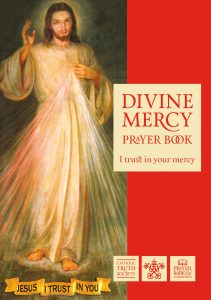 This blog is extracted from our book Divine Mercy Prayer Book. A collection of prayers associated with the Divine Mercy devotion and extracted from St Faustina’s diary are included here alongside traditional Catholic prayers. An explanation of the Divine Mercy devotion and its origins is also included.
This blog is extracted from our book Divine Mercy Prayer Book. A collection of prayers associated with the Divine Mercy devotion and extracted from St Faustina’s diary are included here alongside traditional Catholic prayers. An explanation of the Divine Mercy devotion and its origins is also included.
For more on the Divine Mercy devotion and to support the mission of CTS, order your copy of Divine Mercy Prayer Book today.
